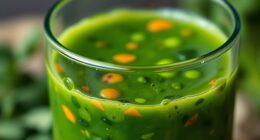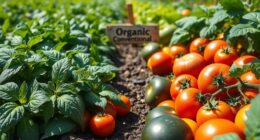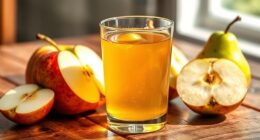After a cleanse, start reintroducing foods slowly with gentle options like soups and steamed vegetables. Soups help hydrate you and provide essential nutrients while being easy to digest. Steamed veggies offer fiber and vitamins that support your recovery. Gradually add more variety, paying attention to how your body reacts, and avoid processed foods. Building your meals around nourishing, simple ingredients helps maximize benefits and sets the stage for sustainable healthy eating—more tips await to guide your process.
Key Takeaways
- Reintroduce foods gradually, starting with gentle options like soups and steamed vegetables to monitor tolerance.
- Use clear broths and vegetable-based soups to hydrate and supply nutrients during initial reintroduction.
- Incorporate steamed vegetables such as zucchini and carrots to support digestion and nutrient absorption.
- Observe your body’s reactions to new foods, noting any sensitivities or discomfort for future adjustments.
- Plan meals ahead with batch-cooked soups and steamed veggies to maintain a nourishing, clean-eating routine.

After completing a cleanse, reintroducing foods carefully is vital to identify what your body tolerates best. This step allows you to enjoy the detox benefits fully while understanding your body’s signals. As you begin this process, focus on gentle, nourishing foods like soups, steamed vegetables, and light proteins. These options are easy to digest and help you maintain the momentum of your cleanse without overwhelming your system. Planning your meals thoughtfully becomes essential here. You want to choose foods that support your body’s healing and avoid any that might cause discomfort or adverse reactions. Proper meal planning guarantees you stay aligned with your health goals while slowly expanding your diet.
Soups are a great way to reintroduce nutrients without stressing your digestive system. Clear broths, vegetable-based soups, or light chicken soups provide hydration and essential minerals, which support detox benefits. You can start with simple recipes made from fresh, whole ingredients, paying attention to how your body responds. As you progress, gradually add more ingredients like soft vegetables or cooked grains, noting any sensitivities. Soups also make meal planning easier—by preparing large batches, you ensure you have nourishing options ready, reducing the temptation to reach for processed or less healthy choices.
Steamed vegetables are another gentle reintroduction method. They’re easy to prepare and digest, providing fiber, vitamins, and minerals that help your body rebuild and reset. You might begin with mild-tasting vegetables like zucchini, carrots, or spinach, steaming them until tender. This method preserves nutrients while making the food easier on your digestive system. As you become more comfortable, you can introduce a wider variety of steamed veggies, observing how each affects your digestion. Incorporating steamed vegetables into your daily meals enhances your meal planning, giving you a healthy, flexible foundation to build on. Additionally, paying attention to the contrast ratio of your meals, such as combining light foods with more substantial options, can help optimize your digestion and nutrient absorption.
Frequently Asked Questions
How Long Should I Wait Before Reintroducing Solid Foods?
You should wait about 24 to 48 hours before reintroducing solid foods, depending on your body’s response. Pay close attention to timing considerations and monitor symptoms carefully. If you experience no discomfort or adverse reactions, gradually add in soups and steamed veggies. Take it slow, and if symptoms reappear, give yourself more time before trying solids again. Listening to your body is key to a smooth progression.
Are There Foods I Should Avoid During Reintroduction?
During reintroduction, avoid trigger foods that may cause food sensitivities or reactions, such as processed sugars, refined carbs, dairy, and gluten. These can irritate your digestive system or provoke unwanted symptoms. Stick to gentle, whole foods initially, and watch for any signs of sensitivity. If you notice discomfort or reactions, eliminate those foods and consult with a healthcare professional to identify your specific trigger foods.
Can I Reintroduce Dairy or Gluten Immediately?
You shouldn’t reintroduce dairy and gluten immediately after your cleanse. Start with dairy reintroduction gradually, observing how your body reacts, especially if you suspect sensitivities. For gluten reintroduction, wait a few days after dairy, and reintroduce it slowly in small amounts. This approach helps you identify any adverse reactions and minimizes digestive discomfort. Taking it slow guarantees a smoother progression back to a more varied diet.
What Signs Indicate I Should Pause Reintroduction?
If you notice persistent digestive discomfort or unexpected skin reactions, it’s a clear sign to pause reintroduction. Imagine your body sending signals—bloating, cramps, rashes—that warn something’s off. These symptoms indicate your system needs a break, and ignoring them could lead to more serious issues. Trust your body’s cues; when in doubt, pause and reassess before proceeding. Your health depends on listening carefully.
How Can I Tell if a Food Causes an Adverse Reaction?
You can tell if a food causes an adverse reaction by paying attention to food sensitivity and allergy symptoms. Notice if you experience symptoms like bloating, stomach pain, hives, or difficulty breathing within a few hours after eating. Keep track of what you eat and how you feel. If symptoms persist or worsen, stop eating that food and consult a healthcare professional to determine if it’s a true allergy or sensitivity.
Conclusion
As you reintroduce foods after your cleanse, remember to listen to your body and reintroduce items gradually. Soups and steamed veggies are gentle options to start with, helping you ease back into regular eating. Did you know that 70% of people report increased energy and better digestion after mindful reintroduction? Keep track of how different foods make you feel, and enjoy this new chapter of nourishing yourself thoughtfully. Your body will thank you for it!
Cindy thoroughly researches juicing trends, techniques, and recipes to provide readers with practical advice and inspiration. Her writing style is accessible, engaging, and designed to make complex concepts easy to understand. Cindy’s dedication to promoting the advantages of juicing shines through her work, empowering readers to make positive changes in their lives through the simple act of juicing.











